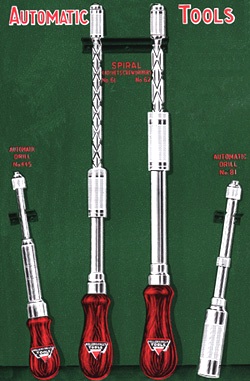Millers Falls Push Drills and Spiral Screwdrivers
 The Millers Falls Company used the term 'automatic' to refer to tools that "incorporate a bobbin sliding up and down a spiral shaft to either bore a hole or drive a screw."(1) The term entered the company's lexicon in the 1870s when it began selling a handy little drill patented by William J. Johnson that drilled holes by means of a simple back and forth motion of the user's hand. The 'automatic' fell out of favor for describing the company's screwdrivers in the late 1920s when models featuring a ratcheting spring-loaded automatic return were tagged with the identifier 'spiral ratchet.' The term 'automatic' continued to be applied to Millers Falls push drills through the early 1980s. At times, spiral push drills are referred as Archimedean drills. This latter usage is most common when the tool being referred to is not spring loaded.
The Millers Falls Company used the term 'automatic' to refer to tools that "incorporate a bobbin sliding up and down a spiral shaft to either bore a hole or drive a screw."(1) The term entered the company's lexicon in the 1870s when it began selling a handy little drill patented by William J. Johnson that drilled holes by means of a simple back and forth motion of the user's hand. The 'automatic' fell out of favor for describing the company's screwdrivers in the late 1920s when models featuring a ratcheting spring-loaded automatic return were tagged with the identifier 'spiral ratchet.' The term 'automatic' continued to be applied to Millers Falls push drills through the early 1980s. At times, spiral push drills are referred as Archimedean drills. This latter usage is most common when the tool being referred to is not spring loaded.
Push drills are lightweight tools intended for light jobs and the quick drilling of small diameter holes. Spring loaded, they return to their original position after each downward push by the user. Although much of the boring occurs on the down stroke, bits designed to cut in two directions maximize the return on the user's effort. The Millers Falls Company's earliest push drills were intended for very light jobs such as making starter holes for saw blades in scroll work pieces or for drilling in thin sheets of such soft metals as brass. In the 1890s, the company began marketing more substantial models, and although they were capable of drilling somewhat larger holes, the biggest improvements lay in their durability and improved ergonomics. By the end of the first decade of the 20th century, most, though not all, models were manufactured with bit storage compartments in the handle.
Millers Falls added spiral screwdrivers to the line at the time it began beefing up its push drills. These early tools were not spring loaded. A worker using a springless screwdriver would hold grasp a rotating sleeve behind the bit with one had and push with the other. The tools are very effective since the hand grasping the sleeve is close to the screw—a feature that aids in holding the screw in position as it is started. Spring loaded screwdrivers soon followed, and although it was no longer necessary to place one hand behind the bit to power the tool, the handy rotating sleeve arrangement was so basic to the tool's control that it remained.
Screwdrivers with a single spiral move in only one direction and can be used for driving screws only. Sometime around 1900, the company began to offer a double spiral model which could be used to withdraw screws as well. The first two-spiral models were not spring loaded but relied on the rotating sleeve arrangement. Improved models with ratcheting functionality soon appeared, and in the 1920s, the Millers Falls Company introduced its first spring leaded, bi-directional ratcheting screwdriver.
- 1. The quoted text in the first paragraph: An elegant and succinct definition of an archimedean (spiral) tool developed by the late Charles Raymond 'Chuck' Zitur.
- Note: Originally a plate in the 1929 company catalog, the illustration on this page has been altered substantially.